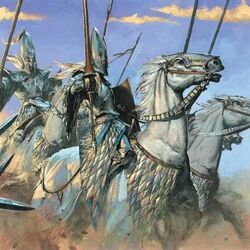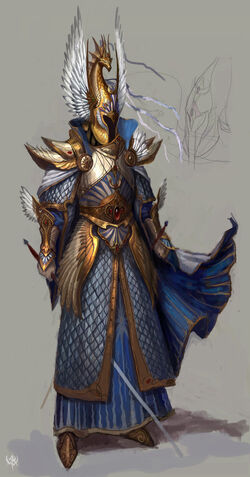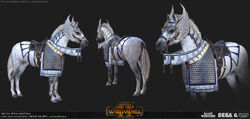
High Elf Silver Helms protect their Elven Steeds with ithilmar barding, which is hard as steel and light as silk.
Ithilmar ("sky-silver" in Eltharin) is a wondrous, lightweight metal found only in Vaul's Anvil, the largest volcano in Ulthuan.[1a] Forged by Elven smiths, ithilmar is priceless, and serves as an excellent alternative to steel or iron mail.[3b] In Norsca, it is also known as the "witch-metal" of the Elves.[5a]
History[]
The black slopes of the Dragonspine Mountains of Caledor in Ulthuan are often shrouded in steam from the many volcanic peaks of the region. The mountains' shoulders have been built up over many thousands of years by deposits brought up from the mortal world's fiery core. According to Elven legends it was the very gods who dug deep beneath the earth's crust to find the secret gems and minerals that are concealed there.[1a]

A High Elf Prince outfitted in ithilmar scale armour.
Today the mountainsides are studded with veins of wondrously coloured minerals, precious stones and metal ores, many found only in this part of the Known World. These gems are prized by both High Elf and Dwarf craftsmen, and many have magical and unusual natural properties.[1a]
The High Elves themselves do not mine for gems or minerals, but harvest the exposed slopes for stones loosened by erosion and by the occasional tremors that shake the mountains around Vaul's Anvil. This is the largest of the volcanic mountains of the range, the legendary seat of Vaul, the Elven god of smiths. Under its steam-clad slopes can be found the world's sole vein of the metal known as ithilmar.[1a]
Ithilmar means "sky-silver" in Eltharin, for it is said to be as light as the sky and as lustrous as polished silver. Ithilmar does not tarnish, and is a delight to work, and yet it is as hard as steel. Only the High Elves know how to forge it, though a Dwarf Runesmith would surrender his family's entire treasure hoard to learn its secret. In fact, ithilmar can only be forged with the addition of other mineral ores found uniquely on the slopes of the Dragonspine Mountains, so the only weapons shops that make it are those of Vaul's Anvil itself.[1a]
The High Elves use ithilmar to forge armour and weapons, and can make blades, corselets and tall helms of extraordinary lightness. Not all weaponry is made of this by any means, for ithilmar is too precious to use heedlessly, but it is used mainly to equip superior troops. It is highly valued for blades which retain their keen edge, and for long coats of scale armour which would otherwise weigh down and seriously discomfort a slightly built Elf.[1a] It is also used to make barding, which affords the same protection as heavy steel, but without slowing down the Elven Steed that wears it.[2a]

High Elven ithilmar barding on an Elven Steed as rendered for Total War: Warhammer II.
Ithilmar is rarely found anywhere outside of the High Elven kingdoms of Ulthuan, as objects crafted from it are never for sale and must be found, stolen, or bestowed.[3a][3b] Among the High Elven merchants who trade in the great cities of the Empire, a few, especially among the retired warriors, keep suits of exquisite chain mail. Light and durable, ithilmar mail represents the height of High Elven capability in armoursmithing. While not magical, it's rumoured that only the greatest of High Elven wizards can forge it.[3a]
On occasion, an ithilmar weapon will surface, sometimes as spoils of war, especially among the treasures of the Norscan Reavers who frequently raid Elven coastal settlements.[3b]
The silvery steel of the High Elves is said to hold uncanny magical power -- in fact, some Vampires are known to burst into flames upon being cut by a weapon forged from ithilmar.[4a]
Sources[]
- 1 Warhammer Armies: High Elves (5th Edition)
- 1a pg. 55
- 2 Warhammer Armies: High Elves (6th Edition)
- 2a pg. 15
- 3 Warhammer Fantasy Rolkeplay 2nd Edition: Old World Armoury (RPG)
- 4 Warhammer Fantasy Roleplay 2nd Edition: Night's Dark Masters (RPG)
- 4a pg. 114
- 5: Palace of the Plague Lord (Novel) by C.L. Werner
- 5a: Ch. 2

